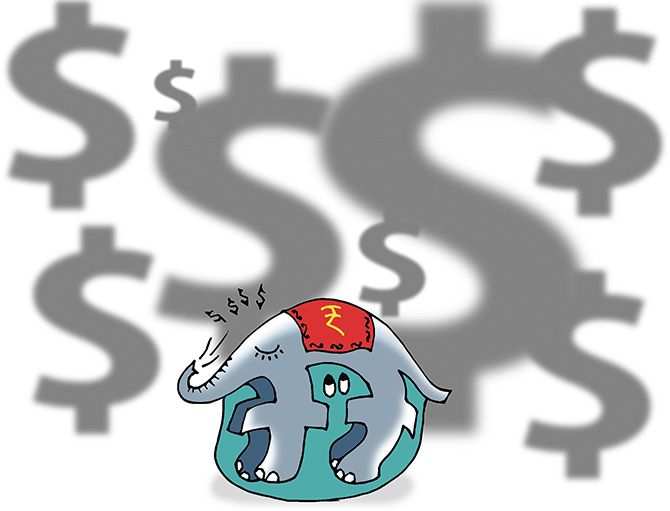We are much better placed than in 2013 with our overall fundamentals much stronger - higher foreign exchange reserves, a more favourable growth-inflation mix and an institutional framework for targeting inflation, says B Prasanna.
Illustration: Dominic Xavier/Rediff.com

One cannot fault the currency markets for feeling a sense of déjà vu in the last few weeks although some intermittent relief has been felt recently.
Emerging market (EM) currencies have been on a roller-coaster ride, similar to the “taper tantrum” period, only this time around it could be characterised as a “trade tantrum”.
Today’s markets are reverberating ever so much to tweets and hashtags that June 28, 2018, will be remembered in social media as the day the rupee hit a life low against the dollar, slightly north of the 69 mark.
Although it feels as though we’ve seen this movie before, the plot is markedly different this time and we should recognise the dissimilarity.
Policy responses and market reactions will have to account for this.
The 2013 event occurred as a violent reaction to fears about monetary policy withdrawal when markets were not convinced about the sustainability of global growth and were mostly also unprepared for the eventuality of the punch bowl being taken away.
Some of the key emerging markets, notoriously called as the “Fragile Five”, had also witnessed a marked deterioration in some of the key fundamental factors such as current account deficit, fiscal deficit, inflation etc.
India was unfortunately right on top of this pile of weakness and faced the ire of equity and bond market vigilantes who voted with their feet.
Since then, however, there has been a substantial change in a number of metrics.
First, the global backdrop had improved significantly marked by a near 'Goldilocks' scenario with strong synchronised global growth, benign inflation, diminishing policy uncertainty and stable oil prices and asset markets.
This gave global central banks the confidence to tighten policy and the US went ahead and raised interest rates and initiated the process of balance sheet reduction.
Global central banks have also started to telegraph policy decisions well so tail risks from monetary policy adjustments are now lower.
Second, India too had improved substantially in the EM rankings with marked improvement in almost all parameters from 2014 to 2017.
Come 2018, the strength of the dollar has been the biggest sensation that has taken everyone by surprise.
While the US-Iran standoff amid severe supply outages in the crude oil market has led to multi-year highs in Brent prices, the significant ramp-up in the global protectionism wave (read trade wars) initiated by US President Donald Trump has led to a series of blow-for-blow threats across the globe affecting almost all major regions especially the European Union (EU) and China.
Intermittent episodes of stress from EU political triggers - from Italy and Germany etc. - have also contributed to the dollar strength.
Additionally, the economic scenario has also seen significant changes with the synchronised 2017 growth giving way to a two-speed world with the US staying strong while other regions such as the EU, the UK and Japan slowing down.
This led to a widening of the monetary policy differential between the regions.
The combination of the above developments has resulted in sharp strengthening of the dollar and record capital outflows from EM nations.
Predictably, EM currencies have witnessed sharp depreciation pressures in proportion to investors’ perception of their external vulnerabilities.
Countries such as Turkey, Argentina, Brazil, South Africa etc. have been under pressure and their central banks have resorted to various avenues including rate hikes to support their respective currencies.
Also, currencies that were relatively over-valued in REER terms have seen the most correction in recent days.
Against this backdrop the rupee has had its own reasons for the gradual depreciation.
The sharp rise in crude prices have left us vulnerable on the current account front with the deficit expected to widen by approximately five times from the lows of around $14 bn in FY2017.
There has been an increase in non-oil imports without the mitigating effect of robust growth in exports.
While the absolute deficit number looks ominous but at around 2.5 per cent of GDP, it looks more manageable now as compared to the 2013 highs of around 5 per cent.
This brings us to the funding problem.
Foreign institutional investor outflows in the fiscal year to date stand at approximately $9 bn thereby exacerbating the already stretched balance of payment situation.
We expect a balance of payment deficit of at least $10 bn with strong upside risks depending on how foreign portfolio investments investments behave.
From a medium-term perspective, we are much better placed with our overall fundamentals being much stronger with a more favourable growth-inflation mix, higher foreign exchange reserves and institutional framework for targeting inflation.
All these help to engender more confidence in domestic assets.
Even though depreciation is clearly on the cards, the process is unlikely to be as disruptive as it was in 2013.
On balance, we expect the rupee to remain weak for some time and could even gradually test the 70 handle on severe risk aversion episodes.
Oil prices have recently declined sharply amid some positive developments on the supply front.
Even though some spikes can’t be ruled out, a sustained break above the $80/bbl seems less likely at the moment given the recent reassurances given by major oil producers.
Some respite in oil prices will also provide some comfort to the rupee.
Ironically, the medium-term pressure of the twin deficits on the dollar could be the reason why dollar bulls might have to retreat in the second half of this year.
Whether G7 currencies are the only beneficiaries of this weakness or even EM currencies stand to profit, only time will tell.
B Prasanna is group executive, head - Global Markets Group, ICICI Bank.











